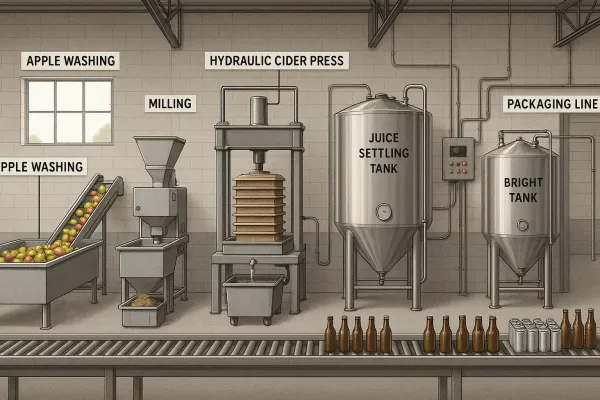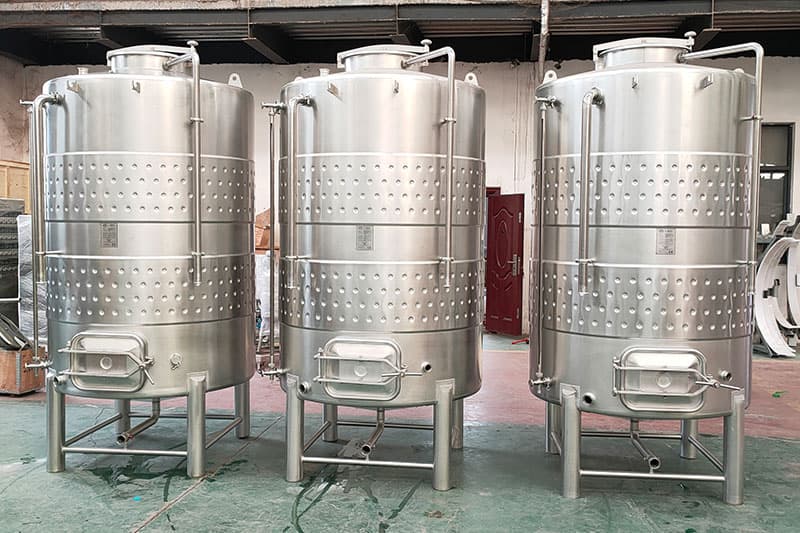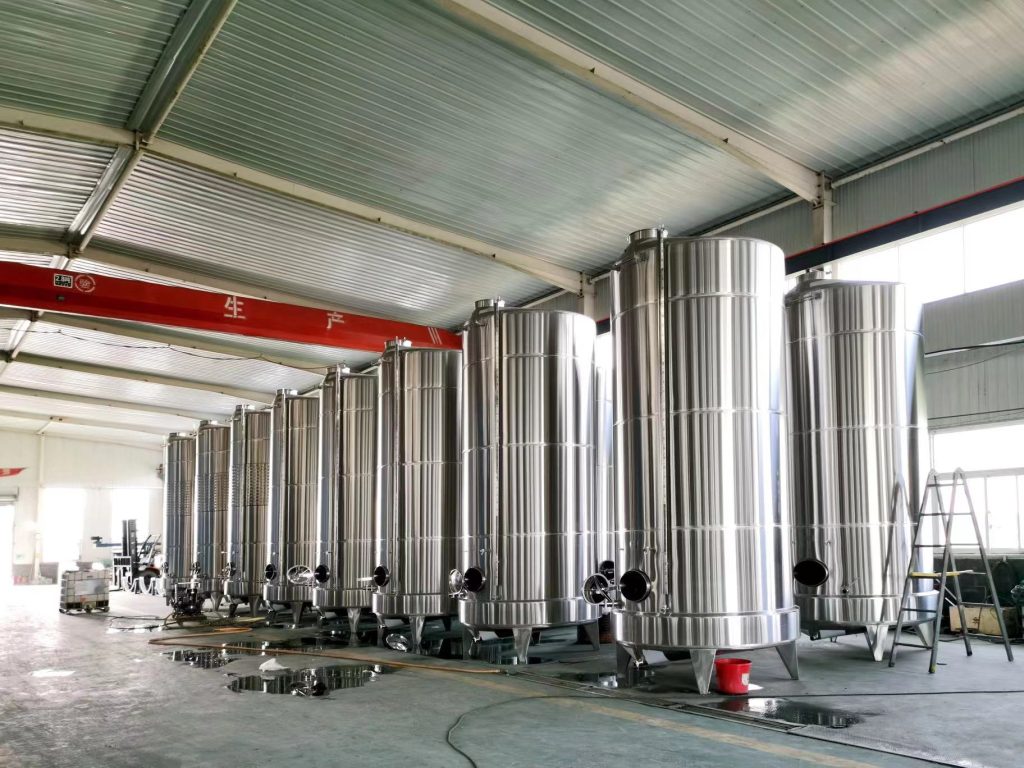Starting a cidery sounds exciting, but choosing the wrong cider equipment or press can drain cash. Confusing specs slow cider production and push back launch dates. This guide makes cider setup simple—clear gear lists, smart fermentation choices, and a practical ROI model you can use today.
To start a cider business, map your process (wash → mill → press → settle → fermentation → condition → package), pick food-grade stainless steel vessels sized to demand, and standardize sanitation and temperature control. A hydraulic cider press, conical fermentation tanks, a bright tank, and bottle/can lines form your core. Model CAPEX/OPEX, price your cider, and project cash flow to estimate ROI within 18–36 months.
Table of Contents
1. What equipment do you actually need to make cider at commercial scale?
Whether you’re building a small, small-scale pilot room or a full commercial cider plant, the core steps of cider production don’t change: receive apple, wash, mill, press, clarify, fermentation, conditioning, and bottle/keg/can. The essential pieces of equipment are a washer/er, mill, fruit press, juice collection tank, stainless steel fermenters, a conditioning/bright tank, and a packaging line. Add a CIP cart for sanitation and a glycol loop for temperature control.
For a tight, proven baseline, review a turnkey cider making equipment package that integrates milling, press, tankage, and packaging blocks. See this commercial cider making equipment overview to compare vessels, agitation, and controls in one place: cider brewing equipment. This keeps the production line cohesive and helps minimize downtime between steps.
Why this matters: a coherent layout means shorter hoses, faster transfers, and less oxygen pickup—key to clean cider aroma. It also helps first-time cider makers document a repeatable fermentation process so every batch tastes like your brand.

2. Choosing the right press: fruit press vs hydraulic presses—what’s best for your cidery?
Your press sets your extraction rate and clarity. Basket and bladder fruit press systems are simple and ideal for small batch pilots. Hydraulic presses increase throughput and help minimize hand labor. Many modern presses are designed to drain quickly, keep oxygen low, and prevent bitter phenolics from over-pressing. Look for a right press with drain channels that move apple must efficiently and washable screens that hold up to daily sanitation.
As capacity grows, press capacity (kg/hr or tons/hr) should match milling speed so juice isn’t waiting in the line. For side-by-side specs, you can also browse apple cider making equipment that pairs mills and press heads sized for your forecast: apple cider making equipment. Well-matched presses offer stable yields, clean juice, and smoother staffing.
“Choose for flow, not just maximum pressure. The best cider press works with your mill and tanks like gears in a watch.”
3. Stainless steel fermentation: tanks, yeast, and temperature control and sanitation
After pressing, yeast to convert the sugars in the juice is the engine that turns juice into alcohol. Use jacketed, food-grade, conical tanks for stainless steel fermentation; they’re easy to CIP, and cone bottoms hold trub so you can rack bright cider. With precise temperature control, you’ll guide the fermentation speed and aromatics—from fresh apple esters to hard cider structure—over weeks to several months, depending on style.
Sizing matters. Match total fermentation volume to two to three weeks of sales so you can rotate tanks without stockouts. If you’re looking to expand, modular valves, sample ports, and racking arms speed lab checks and ferment transfers. For tank features tailored to cidery use, see a purpose-built vessel like a jacketed, conical cider fermenter.
Checklist for clean, high-quality cider
- Sanitation: CIP spray balls, caustic + acid cycles, and final rinse.
- Temperature control: 10–18 °C for many cider strains; hold steady.
- Yeast: choose strains that preserve apple character; trial in a pilot batch.

4. From apple to bottle: a simple cider production line that reduces downtime
A lean production line turns fresh apple juice into finished cider with fewer transfers and less downtime. A typical flow: press → settling/enzymes (optional) → fermentation tank → bright tank for polishing → bottle/keg/can. Many commercial producers choose a bright tank for cider conditioning; it clarifies and carbonates before packaging.
For packaging, decide how your market drinks your cider. Glass says “heritage,” cans say “adventure,” and kegs feed taprooms. Pair your conditioning tank with a reliable bottle filling machine to keep oxygen low and crowns consistent. If you plan to add RTDs or festival formats, integrate a compact beer can filling machine (ideal for brewing cider too) and stage pallets to relieve the line.
Pro move: keep hoses short, purge with CO₂, and standardize quick-connects. You’ll minimize oxygen and speed the day.
5. Sizing your cidery: small-scale batches vs commercial production
Right-sizing is the fastest path to profitability. A small-scale cidery might run 500–1,000 L batch sizes and sell direct in a taproom. Commercial production adds wholesale, which means more cider in cold storage and greater packaging throughput. Inventory goals should match lead times; “fast” cider may pass from fermentation to package in 3–5 weeks, while aged cider takes longer.
Think like a brewery: forecast demand, then add 20% headroom for seasonal spikes and new SKUs (types of cider like dry, semi-dry, spiced, or perry). Anchor your tank farm with a bright tank for polishing and carbonating. For a general overview of scalable kits that inform tank counts and footprint, see brewing equipment. While designed for beer, the same engineering logic applies to cidery layouts.
Quick sizing rules
- Fermenter volume ≈ 2–3× weekly sales.
- Bright tank volume ≈ 0.5–1× daily packaging rate.
- Packaging capacity > peak wholesale ship days.

6. ROI math: initial investment, cash flow, and return on investment (ROI)
A realistic ROI plan keeps your cider dream grounded. Start with initial investment (building prep, cider press, tanks, glycol, packaging) and build an OPEX model (fruit, yeast, CO₂, utilities, labor, lease, distribution). Price your cider SKUs (taproom pint, bottle, 4-pack, keg), then model cash flow by month.
Typical CAPEX for a 1,000–2,000 L cidery (illustrative)
| Block | Budget (USD) |
| Mill + press (semi-auto, hydraulic) | 25,000–60,000 |
| 3× 1,000 L stainless steel fermenters | 24,000–45,000 |
| 1× 1,000 L bright tank | 7,000–16,000 |
| Glycol + chiller | 8,000–20,000 |
| Racking, pumps, CIP | 5,000–12,000 |
| Packaging (starter bottle line) | 18,000–45,000 |
| Lab, hoses, fittings | 3,000–8,000 |
| Setup & install | 6,000–15,000 |
| Total | 96,000–221,000 |
Simple ROI example (illustrative):
- Average wholesale revenue: $65 per 12-bottle case (750 ml).
- Average COGS (fruit, packaging, utilities): $28/case.
- Gross margin: $37/case.
- Sell 600 cases/month → $22,200 gross → $12,200 after fixed OPEX.
- Return on investment recovers $150k CAPEX in ~12–18 months if volumes hold. Actual roi depends on your channel mix and cider price.
If you plan to scale packaging sooner, explore modular 15–20 bbl kits to anchor utilities and piping, then add tanks later: brewery equipment for sale.
“Price discipline and inventory discipline build a durable cidery business.”
7. Marketing and branding: carve a place in the cider market
Marketing and branding for cider is about a promise: a bright apple core, a clean finish, and a story that fits your region. Tell the guide to cider you wish you had: orchard sourcing, fermentation choices, and how your cidery avoids shortcuts. Use taproom cues (glassware, fonts, label color) to signal craft cider quality. Watch industry trends like session-strength cider and fruit-forward blends to meet demand for cider that’s refreshing, not heavy.
Labels go further when they explain flavor, sweetness scale, and types of cider. If you also produce fruit wine or collaborate with a neighbor winery, your portfolio deepens for distributors. Position your hard cider business as a proud local cider voice with modern quality. Thinking of side projects? A quick look at wine making equipment can inspire co-ferments that use the same cellar, boosting profitability.
Brand tips (quick):
- Keep it simple: name, style, sweetness.
- Be visual: orchards, seasonal art, clean icons.
- Be available: cans for trails, bottle formats for shelves.
8. FAQs for starting a cidery (faqs)
How long does cider fermentation take?
Most fermentation runs 10–21 days at controlled temps, then conditioning. Some cider matures for weeks to several months. Pace depends on yeast, sweetness targets, and tank temps.
Can I make pear cider (perry) with the same gear?
Yes. Your mill, press, tanks, and bright tank still work. Pear behaves differently in the press and fermentation, so run a pilot batch and adjust enzyme and nutrient plans.
Do I need a brewhouse like a brewery to make cider?
No mash tun needed; you’re not converting grain. You need a mill, press, juice tanks, stainless steel fermenters, conditioning, and packaging. Browse cider-centric kits: equipment for cider making.
What packaging should I start with—bottles, cans, or kegs?
It depends on your market. Taprooms love kegs; stores love 4-packs. Start with one line and add later. If draft is key, a compact beer keg filling machine keeps draft cider moving without bottlenecks.
Is sanitation really that important?
Yes. Clean lines are the difference between bright cider and off-flavors. Follow temperature control and sanitation SOPs, keep hoses off floors, and verify CIP cycles. Your cider will thank you.
Can I start cider at home and then go pro?
Absolutely. Home production and home brewing trials help you prove recipes. But commercial operations require food-grade gear, proper drains, and documented QA.
Practical equipment map (at a glance)
Core blocks
- Orchard intake → washer → mill → press (basket, bladder, or hydraulic)
- Juice tank → fermentation (conical, jacketed) → bright tank
- Packaging: bottle/can/keg lines
One-day startup checklist
- Confirm press capacity vs milling rate
- Verify glycol setpoints for temperature control
- Stage dry goods (crowns, labels) to avoid downtime
- Record gravities; track ferment to target FG
Useful add-ons
- Inline filters for polish
- Dissolved oxygen meter
- Lab bench for titratable acidity and pH
Light case study: “Whether you’re just starting” or scaling
A new cidery launched with a 1,000 L batch system, bladder press, two jacketed conicals, and one bright tank. They needed to minimize initial investment yet keep headroom. Three months in, demand outpaced plan. The team added one more fermenter and a semi-auto capper. Because utilities and drains were pre-planned, the setup took one day, and downtime stayed low. Six months in, they introduced hard cider variants and a seasonal apple–pear blend. This schedule aligned cash coming in with tanks going out—healthy cash flow without surprises.
“Choose the right equipment for today—plumb for tomorrow.”
The one-page cider vocabulary (for teams & investors)
- Cider: fermented apple juice.
- Hard cider: alcoholic cider.
- Cider press/press: extracts juice from milled fruit.
- Fermentation: yeast converts sugars in the juice to alcohol.
- Bright tank: conditioning and carbonation before package.
- Commercial cider: wholesale-ready cider with documented QC.
- Cidery: facility where you make cider professionally.
Optional gear upgrades when demand jumps
- Larger hydraulic press head and quicker screens (faster turns).
- Extra bright tank (staging carbonated cider for packaging).
- Inline pasteurizer for shelf-stable SKUs.
- Cartoner/pack-off table to keep the production process smooth.
When the time is right, these equipment options unlock faster commercial production while holding quality. If your lines are at capacity, a second shift sometimes beats new machines.
Packaging pathways: bright tank to shelf
For polish and carbonation, many teams stage cider in a bright tank before filling. If you plan to lean on bottles at first, add a light rinser and dependable conveyor to your bottle filling machine so crowns seat tight and DO stays low. Some commercial producers move to cans later; a compact beer can filling machine lets you answer trail-friendly formats without rebuilding the cellar.
When budgets allow, a polishing vessel (e.g., bright tank) smooths the last mile. Clear on labels if a pear blend is in the bottle.
Cross-category growth: brewing, wine making, and beyond
If you already operate a brewery, you know process discipline: SOPs, sanitation, cold side care. Those habits translate perfectly to cider. Some cidery teams add co-ferments or seasonal blends, borrowing tanks used for wine making or farmhouse projects. Your cellar, your story—just make sure food-grade hoses are dedicated and flavors don’t clash.
If you ever need a single page that bundles mill-to-package for cider, tap one more time into cider brewing equipment. It keeps your shopping list aligned while you talk distributors.
Mini ROI worksheet (fill-in)
Projected monthly volume (cases): ________
Average revenue per case ($): ________
Average COGS per case ($): ________
Monthly fixed OPEX ($): ________
Gross margin = (Revenue – COGS) × Volume
Operating income = Gross margin – Fixed OPEX
Payback months = CAPEX / Operating income
Tip: run three scenarios (Base / Stretch / Stress). You’ll see how price, fruit cost, and keg vs bottle mix shift your roi window.
Key takeaways (pin these)
- Map your cider flow first; buy gear second.
- Pair mill rate with press capacity to prevent chokepoints.
- Use jacketed stainless steel conicals and tight temperature control.
- Condition in a bright tank to present clear, high-quality cider.
- Start with one package (keg/bottle/can), expand with demand.
- Model cash flow honestly; protect profitability with inventory discipline.
- Build brand cues the cider market recognizes; keep labels clear.
- Whether you’re a pilot room or scaling commercial cider, document SOPs and sanitation.
Note on tone: This guide reflects first-hand implementation work helping cidery teams plan lines, choose cider press modules, and commission stainless steel tanks. It’s designed to read quickly and be shared with partners and investors—whether you’re planning day one or preparing a second site.
